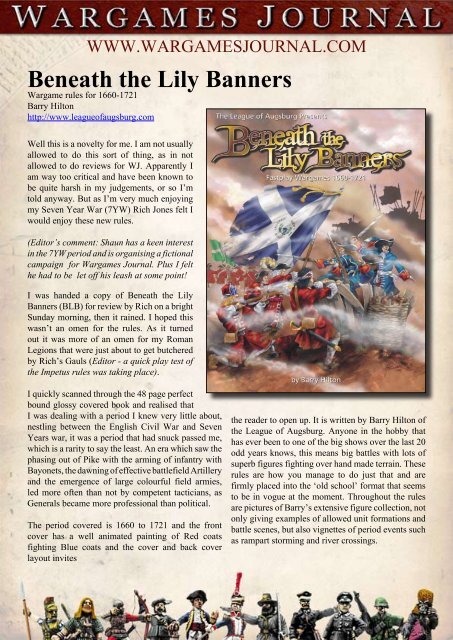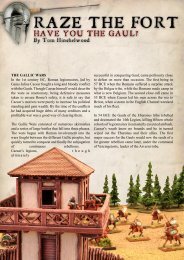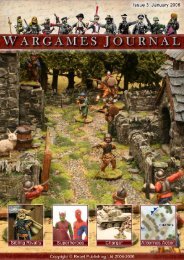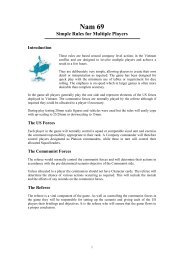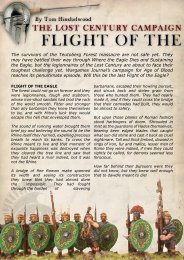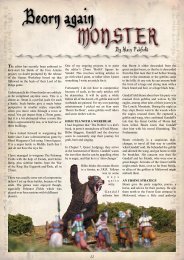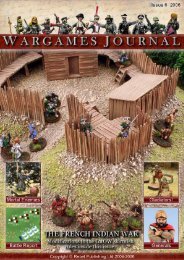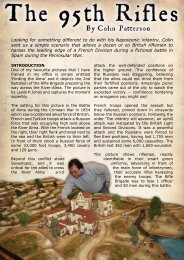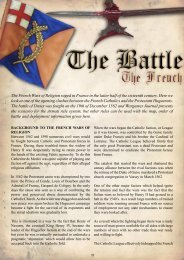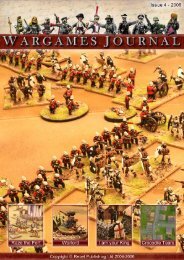Beneath the Lily Banners - Rebelpublishing.net
Beneath the Lily Banners - Rebelpublishing.net
Beneath the Lily Banners - Rebelpublishing.net
You also want an ePaper? Increase the reach of your titles
YUMPU automatically turns print PDFs into web optimized ePapers that Google loves.
WWW.WARGAMESJOURNAL.COM<br />
<strong>Beneath</strong> <strong>the</strong> <strong>Lily</strong> <strong>Banners</strong><br />
Wargame rules for 1660-1721<br />
Barry Hilton<br />
http://www.leagueofaugsburg.com<br />
Well this is a novelty for me. I am not usually<br />
allowed to do this sort of thing, as in not<br />
allowed to do reviews for WJ. Apparently I<br />
am way too critical and have been known to<br />
be quite harsh in my judgements, or so I’m<br />
told anyway. But as I’m very much enjoying<br />
my Seven Year War (7YW) Rich Jones felt I<br />
would enjoy <strong>the</strong>se new rules.<br />
(Editor’s comment: Shaun has a keen interest<br />
in <strong>the</strong> 7YW period and is organising a fictional<br />
campaign for Wargames Journal. Plus I felt<br />
he had to be let off his leash at some point!<br />
I was handed a copy of <strong>Beneath</strong> <strong>the</strong> <strong>Lily</strong><br />
<strong>Banners</strong> (BLB) for review by Rich on a bright<br />
Sunday morning, <strong>the</strong>n it rained. I hoped this<br />
wasn’t an omen for <strong>the</strong> rules. As it turned<br />
out it was more of an omen for my Roman<br />
Legions that were just about to get butchered<br />
by Rich’s Gauls (Editor - a quick play test of<br />
<strong>the</strong> Impetus rules was taking place).<br />
I quickly scanned through <strong>the</strong> 48 page perfect<br />
bound glossy covered book and realised that<br />
I was dealing with a period I knew very little about,<br />
nestling between <strong>the</strong> English Civil War and Seven<br />
Years war, it was a period that had snuck passed me,<br />
which is a rarity to say <strong>the</strong> least. An era which saw <strong>the</strong><br />
phasing out of Pike with <strong>the</strong> arming of infantry with<br />
Bayo<strong>net</strong>s, <strong>the</strong> dawning of effective battlefield Artillery<br />
and <strong>the</strong> emergence of large colourful field armies,<br />
led more often than not by competent tacticians, as<br />
Generals became more professional than political.<br />
The period covered is 1660 to 1721 and <strong>the</strong> front<br />
cover has a well animated painting of Red coats<br />
fighting Blue coats and <strong>the</strong> cover and back cover<br />
layout invites<br />
<strong>the</strong> reader to open up. It is written by Barry Hilton of<br />
<strong>the</strong> League of Augsburg. Anyone in <strong>the</strong> hobby that<br />
has ever been to one of <strong>the</strong> big shows over <strong>the</strong> last 20<br />
odd years knows, this means big battles with lots of<br />
superb figures fighting over hand made terrain. These<br />
rules are how you manage to do just that and are<br />
firmly placed into <strong>the</strong> ‘old school’ format that seems<br />
to be in vogue at <strong>the</strong> moment. Throughout <strong>the</strong> rules<br />
are pictures of Barry’s extensive figure collection, not<br />
only giving examples of allowed unit formations and<br />
battle scenes, but also vig<strong>net</strong>tes of period events such<br />
as rampart storming and river crossings.
So <strong>the</strong> nit and indeed grit of <strong>the</strong> rules are laid out, as<br />
<strong>the</strong> author says is in a very British fashion. Figures<br />
need not be rebased, but remain as multiples of 6 foot<br />
per base, 3 bases per unit or 3 mounted figures per<br />
base for Cavalry, 3 or 4 bases per unit. Command and<br />
Control is handled easily by a d10 roll to see what<br />
percentage of <strong>the</strong> army activates, none to 100% by<br />
unit. Orders are placed by unit before a big reveal at<br />
<strong>the</strong> start of <strong>the</strong> turn proper. Units can only do <strong>the</strong> most<br />
basic of orders; move, hold, rally or charge, although<br />
all units in <strong>the</strong> army may attempt to shoot at enemy<br />
units that move into range during <strong>the</strong> turn. The turn<br />
sequence of Move/Shoot/Melee will be familiar to<br />
anyone that has been involved in <strong>the</strong> hobby since<br />
Charles Grant or indeed 1 st Edition Warhammer.<br />
Movement is in inches and is <strong>the</strong> standard fare of ‘old<br />
school’ gaming with 4” for foot and 8” for Cavalry,<br />
with some variation for formation and terrain.<br />
Chargers must declare and pass a morale test to charge,<br />
defenders also test to stand and fire or counter charge.<br />
Morale check failure limits <strong>the</strong> orders available and<br />
<strong>the</strong> fighting ability of <strong>the</strong> unit. Musketry firing up to<br />
12”, is accrued by base and cross referenced against a<br />
modified d6 roll, while <strong>the</strong> casualties are marked off<br />
in figures, until 50% of <strong>the</strong> figure count is reached<br />
when bases begin to be removed, provided of course<br />
<strong>the</strong> unit hasn’t been routed off <strong>the</strong> table by <strong>the</strong>n.<br />
Artillery fires as individual guns using multiple d10s<br />
to kill figures at ranges up to 36” away, 48” for siege<br />
guns. Melee uses <strong>the</strong> same casualty chart as firing<br />
but a different set of modifiers; again casualties are<br />
marked in figures. Cavalry melees against Infantry is<br />
a very one sided affair which should be avoided at all<br />
costs, <strong>the</strong> foot don’t get to fight back!! With <strong>the</strong>se<br />
basic rules come optional rules to give more flavour<br />
without adding any complications, such as capturing<br />
standards and in period specific rules for <strong>the</strong> Great<br />
Nor<strong>the</strong>rn war and warfare in <strong>the</strong> East, along with<br />
guidelines for siege combat.<br />
The book comes with 2 scenarios to play through, a<br />
Williamite ambush of some raiding Jacobites (17 units<br />
versus 9 units) which will allow <strong>the</strong> beginner to come<br />
to terms with <strong>the</strong> simplicity of <strong>the</strong> rules. The second<br />
scenario is a rearguard action by <strong>the</strong> Grand Alliance,<br />
against <strong>the</strong> French, after <strong>the</strong> battle of Neerwinden,<br />
(34 units versus 43 units) with <strong>the</strong> French pushing <strong>the</strong><br />
routing Allied forces, lots of Horse v Foot melee here
for <strong>the</strong> more sadistic of gamers. The book rounds out<br />
with a list of campaigns fought during <strong>the</strong> time frame<br />
and bibliography of books used. The rule set comes<br />
with a laminated card QRS that appears complete and<br />
in a very usable order.<br />
The rules have certainly been tested to destruction<br />
and already have a firm online following thanks to<br />
<strong>the</strong> The League of Augsburg’s website and forums.<br />
It uses an ‘old school’ format and hasn’t been written<br />
to re-invent <strong>the</strong> hobby in its own image; ra<strong>the</strong>r it is a<br />
very nice formalisation of <strong>the</strong> genre. It reminded me<br />
of playing my first games of Napoleonic’s with ‘In<br />
<strong>the</strong> Grand Manner’ rules, which to be honest isn’t a<br />
bad thing.<br />
What it isn’t is a book for <strong>the</strong> ‘Flames of War’ crowd<br />
to pick up and start playing games in <strong>the</strong> dying years<br />
of <strong>the</strong> pike and shot era. Although <strong>the</strong>re are many<br />
useful, and pretty, pictures of gaming units <strong>the</strong>re is<br />
no painting guide to follow, or indeed a set of army<br />
lists for beginners to play ‘pick up’ games. While <strong>the</strong><br />
scenarios are <strong>the</strong>re as specific examples of period<br />
warfare, <strong>the</strong>re is no pickup game scenario generator.<br />
But it isn’t aimed at this crowd, so this isn’t so much<br />
a criticism, ra<strong>the</strong>r an observation.<br />
The website forum says to expect more articles and<br />
scenarios in <strong>the</strong> wargames press.<br />
(Editor: Barry has a superb BLB scenario in Issue<br />
9 of Wargames Journal. It’s a superb read, well<br />
illustrated and is a real must for our readers. Even if<br />
you’re not into this period give it a read!)<br />
So having ascertained who <strong>the</strong> rules are aimed at,<br />
we end up with an uncluttered rule book, which is<br />
a novelty in this day and age. I would go as far as to<br />
say that BLB is a lean, mean killing machine of rules<br />
for <strong>the</strong> gamer already committed to <strong>the</strong> period, but<br />
to such an extent that a beginner will struggle to get<br />
much of a kick-start from just this publication.<br />
What I would have liked to see/read more of is an<br />
explanation from <strong>the</strong> designer as to why <strong>the</strong> rules have<br />
developed this way: Why are <strong>the</strong> bases for infantry<br />
45mm by 50mm and not just 50mm square? Why<br />
aren’t <strong>the</strong> cavalry based to <strong>the</strong> same frontage as <strong>the</strong>
foot? What is <strong>the</strong> rationale for Foot not being able to<br />
fight back against Cavalry? I feel <strong>the</strong>se design points<br />
should at least be attempted to be explained, instead<br />
of left in this ‘just so’ way.<br />
These rules have <strong>the</strong> feel of being developed over<br />
many years from a house or club fast play set of rules.<br />
Again, this isn’t a criticism of <strong>the</strong>m. These rules<br />
have a tight feel to <strong>the</strong>m, nothing sits ambiguously<br />
bo<strong>the</strong>ring you. They play very well and do <strong>the</strong>ir job<br />
accordingly.<br />
BLB is a very nice set of rules for <strong>the</strong> big battalion<br />
boys playing <strong>the</strong> conventions or running weekend<br />
club battles in a gentlemanly game of tabletop warfare.<br />
As you read <strong>the</strong> book you can’t help but get drawn<br />
into <strong>the</strong> spectacle of gaming at a massive scale with<br />
1,000s of figures on <strong>the</strong> tabletop, and you just know<br />
<strong>the</strong>se rules will play such a game well.<br />
The author is clearly setting out his stall to support <strong>the</strong><br />
rules with articles across <strong>the</strong> wargames press and on<br />
his own excellent web site, so I have no fears of <strong>the</strong>se<br />
rules lacking support. Excellent production values<br />
(both with layout and print) makes this an appetising<br />
book to devour for its price tag of £15.<br />
You can watch out for some home grown WJ games<br />
using <strong>the</strong>se rules and we’re already thinking about a<br />
weekend event using <strong>the</strong>m. Final words: a very well<br />
put toge<strong>the</strong>r project that I’m sure <strong>the</strong> author is very<br />
proud of.<br />
Review by Shaun McTague of PEWC (Ponders End<br />
Wargames Club)<br />
AT A GLANCE<br />
50 Pages - Full Colour - Perfect Bound plus A4 Full Colour QRF Sheet<br />
Price: £15<br />
Author: Barry Hilton<br />
Available from http://www.leagueofaugsburg.com


